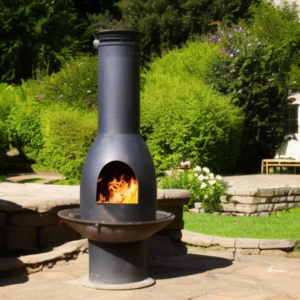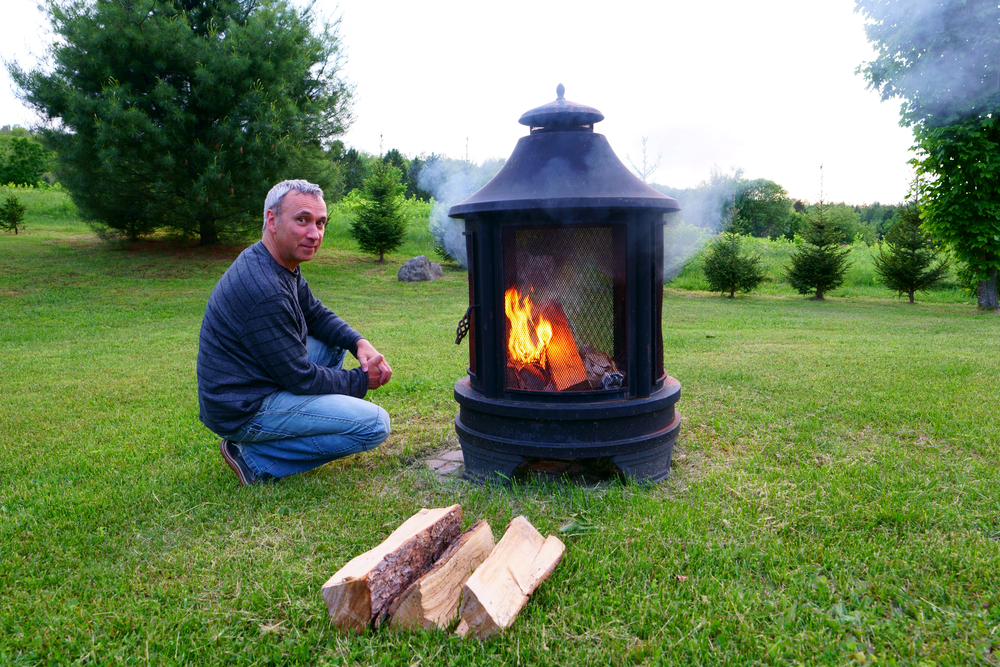Last Updated on February 2, 2023
When it comes to outdoor entertainment, nothing quite beats gathering around a chiminea on a warm summer evening. But before you light up the night sky with your backyard bonfire, there are some important considerations when it comes to putting something under your chiminea. What type of material is best? Can you use a wooden deck? Read on for tips and tricks that will ensure safety while providing all the fun of an open flame.
Table of Contents:
- Chiminea Safety
- DIY Chiminea Base
- Wood Deck Considerations
- FAQs in Relation to What to Put Under a Chiminea
- Conclusion
Chiminea Safety
Why Do You Need Heat-Resistant Material Underneath Your Chiminea?
It’s important to use heat-resistant material underneath your chiminea because it helps protect your deck or patio from damage caused by extreme temperatures. Without this protection, you risk warping wood decks and cracking concrete patios due to prolonged exposure to high temperatures generated by burning logs in the chiminea. Additionally, using heat-resistant materials will help prevent sparks and embers from damaging nearby furniture and other combustible items near your outdoor fireplace.
What Are Some Examples of Heat Resistant Materials to Use Under a Chiminea?
When it comes to choosing the right material for your chiminea, there are a few options available. Concrete pavers are one of the most popular choices due to their durability and heat-resistant properties. They come in various shapes and sizes, making them easy to customise for any outdoor space. Bricks can also be used as a base for a chiminea, although they may not be as durable or heat-resistant as concrete pavers. Sand is another option that provides good insulation from the heat generated by the fire inside the chiminea while allowing air circulation around it. Gravel is also an effective choice when it comes to providing insulation against high temperatures, but it should be kept away from direct contact with flames or sparks.
No matter which material you choose for your chiminea’s base, ensure it is level and stable to avoid any issues with tipping over during use. Additionally, always keep combustible materials such as wood chips or leaves away from your chiminea at all times; this will help prevent accidental fires caused by stray embers or sparks flying out of your fire pit.
DIY Chiminea Base

Creating a DIY chiminea base is an easy and affordable way to protect your outdoor space from the heat of your chiminea. It’s important to have a level surface that will allow proper drainage so you don’t end up with standing water near your fire pit.
Materials Needed
To create a DIY chiminea base, you’ll need concrete pavers or bricks, sand, gravel and some edging material such as plastic border edging or brick edging. You may also want to purchase levelling sand if needed.
Preparing the Area
Before starting on the project, it’s important to make sure the area where you plan on placing your fire pit is free from debris and vegetation. Remove any grass or weeds that are in the area before beginning construction of your base. Once cleared out, use stakes and string to outline where you would like for your fire pit to be placed. This will help ensure that everything is even when constructing it later on.
Laying Out Your Base
Once you’ve determined where exactly you’d like for your fire pit to go, begin laying out either concrete pavers or bricks to form a circular shape which should match up with what was outlined earlier using stakes and string (this step can be skipped if using pre-made circular kits). If using individual pieces, try not to leave any gaps between them as this could cause issues down the line when trying to light fires inside of it due to uneven surfaces, which could lead to sparks flying outside of it more easily than normal, causing potential safety hazards around nearby flammable materials/objects etc.
Adding Sand & Gravel
After laying out all pieces, fill in gaps between each one with sand, then cover the entire surface evenly with about 2 inches worth of gravel (or whatever depth desired). This layer helps provide stability while also helping keep moisture away from bottom layers, thus preventing rot over time caused by excessive dampness coming into contact with wood-burning components inside chimineas themselves during usage periods throughout year(s).
To finish off the project, spread levelling sand across the top layer, making sure there are no bumps or dips present. Then add chosen edging material along the perimeter, creating a neat finished look while keeping everything secure at the same time. With these steps completed correctly, all that is left to do is enjoy your beautiful new addition to your backyard without having to worry about dangerous sparks flying around uncontrollably due to poor construction techniques used during the installation process itself.
Wood Deck Considerations

When it comes to using a chiminea on a wooden deck, the answer is an emphatic no. The intense heat of the fire and smoke can cause damage to the wood over time, leading to warping or cracking. In addition, sparks from the fire could ignite any nearby combustible materials, such as furniture cushions or curtains.
The safest option for enjoying your chiminea outdoors is on concrete or stone pavers that are at least two feet away from anything flammable, like grass, plants, trees and shrubs. If you don’t have access to these materials in your backyard, then consider building a base out of bricks or cinder blocks, which will provide more stability than just placing it directly onto grassy areas.
It’s also important to ensure that there are no combustible items near your chiminea while it’s burning; this includes things like newspaper, kindling wood and other debris that may be lying around in your yard. Additionally, if you plan on having guests over who might be smoking cigarettes, then keep them far away from the area where you’re burning your chiminea, so they don’t accidentally start a fire with their discarded butts.
Finally, never leave your chiminea unattended when it is lit, as even though most models come with safety features built-in, such as spark arrestors, accidents can still happen if left unsupervised for too long. To ensure maximum safety, always put out all fires before leaving home and store all fuel sources safely away from children and pets when not in use.
FAQs in Relation to What to Put Under a Chiminea
What is best to put in the bottom of a chiminea?
The best material to put in the bottom of a chiminea is firebricks. Firebricks are heat-resistant and can withstand temperatures up to 2000°F, making them ideal for use in the base of a chiminea. They also provide insulation, helping to keep your fire burning longer and hotter. Additionally, they absorb some of the smoke from the fire so that it doesn’t escape into your home or garden. For safety reasons, never use flammable materials such as wood chips or leaves at the bottom of your chiminea – only use firebricks.
What do you put at the bottom of a chimenea?
At the bottom of a chimenea, it is important to place some fireproof material such as sand or gravel. This helps to protect the base from heat and prevents any sparks that may escape from igniting nearby materials. Additionally, you should always ensure that your chimenea is on a flat surface and away from flammable items like furniture or curtains. Finally, make sure to keep an eye on your chimenea while in use and never leave it unattended.
Can you stand a chiminea on decking?
Yes, you can stand a chiminea on decking. However, it is important to take certain precautions when doing so. Firstly, make sure that the decking is strong enough to support the weight of the chiminea and any fuel used in it. Secondly, ensure that there is adequate ventilation around the chiminea to prevent smoke or fumes from accumulating underneath your decking. Finally, always use a fireproof base, such as bricks or stones beneath your chiminea, for extra protection against heat damage. Following these simple steps will help keep your deck safe and sound while enjoying your outdoor fireplace.
Conclusion
Overall, when it comes to putting something under a chiminea, safety should be your number one priority. Heat-resistant materials are the best option for protecting your deck and ensuring that you can enjoy your outdoor fire safely. Whether you choose to make a DIY base or purchase one from a store, just remember that wood decks need extra protection and consideration before adding any type of heat source. With the right precautions in place, you can rest assured knowing that your chiminea is safe and secure no matter what material you put under it.
Paul is the type of person who never met a problem he couldn’t fix. He can always be found tinkering with something in his house, even if it isn’t broken! His tips and tricks are often shared on our site. He’s the one you call when something breaks because he has been known to improvise fixes for everything from leaky faucets to malfunctioning dryers.

